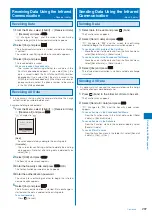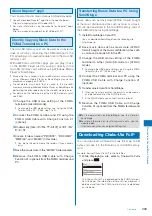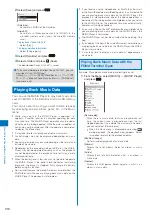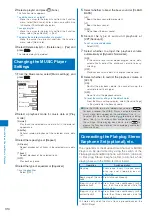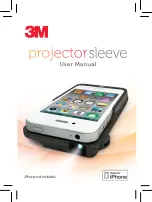
308
Music&Video Channel/Music Pla
ybac
k
■
Format supported for playback
Format
Description
WMA
A sound compression technology developed
by Microsoft Corporation, which is employed
as the Windows standard sound compression
technology.
AAC-LC
A s o u n d c o m p r e s s i o n t e c h n o l o g y u s e d
i n M P E G 2 a n d M P E G 4 , e n a b l i n g a h i g h
compression rate while keeping the sound
quality.
HE-AAC
A sound compression technology used in
MPEG4, which is an extended version of AAC
and also employed in the Chaku-Uta Full
®
.
MP3
MP3 is an abbreviation of “MPEG-1 AUDIO
Layer-3” and a sound compression technology
established by MPEG which is the working
group of ISO (International Organization for
Standardization). The music data can be
compressed about 1/10 times than CD data.
“ATRAC3”
One of sound compression technologies of
“ATRAC” developed by Sony Corporation, which
is archived the high compression rate of about
1/10 times than CD data and the high sound
quality.
“ATRAC3plus” A sound compression advanced technology
from “ATRAC3”, which is archived the higher
compression rate of about 1/20 times than CD
data and the higher sound quality.
■
Bit rate supported for playback
File
Format
Bit rate (kbps)
Chaku-Uta Full
®
AAC-LC
8
−
128
HE-AAC(v1)
8
−
128
HE-AAC(v2)
8
−
48
3GPP
AAC-LC
80, 96, 128, 160, 192,
256, 320
HE-AAC(v1)
40, 48, 64, 80, 96
WMA
WMA
48, 64, 80, 96, 128, 160,
192
MP3
MPEG1 Layer3
96
−
320
ATRAC
“ATRAC3”
66, 105, 132
“ATRAC3plus”
32, 48, 64, 96, 128, 160,
192, 256, 320, 352
Typically, the higher the bit rate is, the better the sound
quality, however, also the larger the data size is, resulting in
the smaller number of tracks that can be saved.
■
Maximum number of tracks that can be stored for
operation on the MUSIC Player
Place to save to
Maximum number
of tracks
Data Box
200
microSD memory card: 2G bytes
1,500
●
“ATRAC3”, “ATRAC3plus”, or “WMA” formatted music data
which is copyrighted and saved in the microSD memory
card can be played back only on your SO905i.
●
Some music data saved in the microSD memory card may
not be played back on other FOMA terminals.
Transferring Music Data
You can transfer music data from a PC to the microSD
memory card inserted in the FOMA terminal using
Windows Media Player, Napster
®
appli, or SonicStage.
Transferring a WMA File to a PC Using
Windows Media Player
You can use Windows Media Player 10/11 to import
music data from a music CD to a PC and save it in the
microSD memory card inserted in the FOMA terminal.
1
Install Windows Media Player 10/11 on your PC.
When installing Windows Media Player 10/11 on a PC
running Windows XP, use Windows XP Service Pack 2 or
later version.
When installing Windows Media Player on a PC running
Windows Vista, use Windows Media Player 11.
2
Save a WMA file in the PC.
For the operations on Windows Media Player 10/11, see
the Help of Windows Media Player 10/11.
3
Change the USB mode setting of the FOMA
terminal to [MTP mode].
To change the USB mode setting, see “Using the FOMA
Terminal with a PC” (P.285, step 1 to 3).
Make sure to insert the microSD memory card before
changing to the MTP mode.
4
Connect the FOMA terminal and PC using the
FOMA USB Cable with Charge Function 01
(optional).
5
Transfer music data from Windows Media Player
10/11.
When you transfer a playlist, the playlist can be used as
a WMA playlist on the FOMA terminal.
6
Remove the FOMA USB Cable with Charge
Function 01 (optional) from the FOMA terminal and
PC.
●
A WMA file which is transferred to the microSD memory
card by other FOMA terminal may not be displayed or
played back on your SO905i.
●
When you use the microSD memory card in which a WMA
file is transferred by other FOMA terminal even if the USB
mode setting is set to [MTP mode] and the FOMA terminal
is connected to a PC, the PC may not recognize it. In
this case, either perform the Delete all WMA (P.289) or
format the microSD memory card (P.284). If you format the
microSD memory card, please note that not only music
data but also all other data are deleted.




